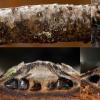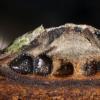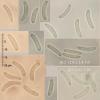
22-04-2013 16:48
Hi to allCould this fungus be Leucostoma persoonii

05-04-2013 09:37
 Gilles Corriol
Gilles Corriol
Bonjour à tous,Je souhaiterais avoir quelques ren

22-04-2013 18:26
 Michel Delpont
Michel Delpont
Bonsoir à tous.Je recherche dans l'article suivan

26-03-2013 12:54
hannie wijersHello,I hope anyone can help me with my "problem"�

21-04-2013 01:06
 Yannick Mourgues
Yannick Mourgues
Branche morte au sol avec Arachnopeziza aurelia, c
Leucostoma on Prunu sp.
Enrique Rubio,
22-04-2013 16:48
Hi to all
Could this fungus be Leucostoma persoonii or some close species of this genus? It grew on Prunus sp. branches at 1000 m ofaltitude. I don't know its Cytospora anamorphic state.
Do you know some modern keys of Leucostoma?
Thanks again
Vera Hayova,
24-04-2013 15:58
Re : Leucostoma on Prunu sp.
Hello Enrique
Thanks for drawing my attention to this record. Yes, it is Leucostoma persoonii. Its anamorph, Cytospora leucostoma, from otuside looks quite similar but with a single ostiole (rarely with two). The anamorph normally can be found in a separate stroma (unlike in L. cinctum where both stages usually develop in the same stroma, as you may remember we have already discussed here). A third species quite common on Prunus s.l. (incl. Cerasus & Padus), L. auerswaldii, differs from L. persoonii by larger spores and stroma configuration.
As far as I know there is no recently published key for all species of Leucostoma. Although it might be one day........ However, for example for Leucostoma species reported from Bulgaria there is a key in the monograph of Dimitar Stoykov 'Diaporthales of Bulgaria' (2012).
Regards
Vera
Thanks for drawing my attention to this record. Yes, it is Leucostoma persoonii. Its anamorph, Cytospora leucostoma, from otuside looks quite similar but with a single ostiole (rarely with two). The anamorph normally can be found in a separate stroma (unlike in L. cinctum where both stages usually develop in the same stroma, as you may remember we have already discussed here). A third species quite common on Prunus s.l. (incl. Cerasus & Padus), L. auerswaldii, differs from L. persoonii by larger spores and stroma configuration.
As far as I know there is no recently published key for all species of Leucostoma. Although it might be one day........ However, for example for Leucostoma species reported from Bulgaria there is a key in the monograph of Dimitar Stoykov 'Diaporthales of Bulgaria' (2012).
Regards
Vera
Enrique Rubio,
24-04-2013 16:54
Re : Leucostoma on Prunus sp.
Many many thanks, Vera.
Thank you for your kindly help
Thank you for your kindly help


